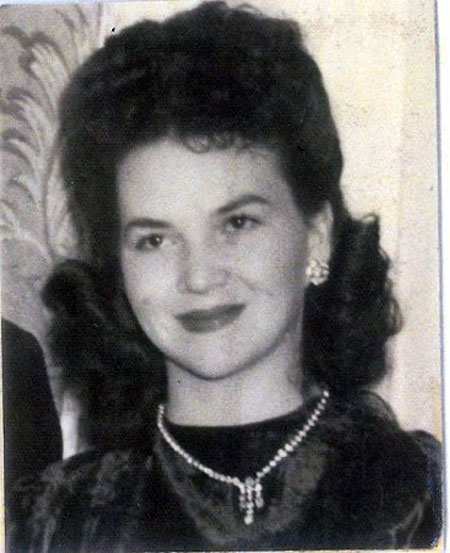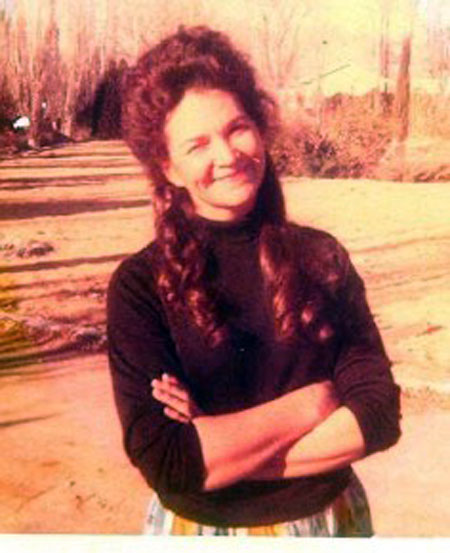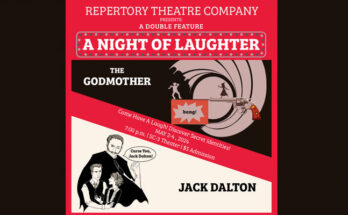EAC Photo: The presentation will take place at the Ranch House at EAC’s Discovery Park.
Contributed Article
SAFFORD – The Graham County Historical Society’s Heritage Award will be presented to renowned local artist Peggy Hancock Curtis Esplin and teacher, religious educator, and LDS leader Keith Crockett. during its annual meeting on Saturday, Jan. 20. The public is invited to attend the ceremony, which will take place at EAC’s Discovery Park Ranch House beginning at 10 a.m.
In addition to the Heritage Awards, an update on the location and construction of the new Graham County Historical Society Museum will be provided.
Come honor and celebrate the legacies and achievements of Peggy Hancock Black Curtis Esplin and Keith Crockett on Saturday, January 20th at 10:00 a.m. at EAC’s Discovery Park Ranch House.
Keith Crockett
“I’m just a plain old farm boy who grew up milking cows and driving tractors,” Elder Crockett says of himself, but his lifetime of teaching the gospel and serving in the priesthood reveals a man who is deeply dedicated to the kingdom of God.
Elder Crockett was born on Jan. 15, 1934, and grew up in Pima, Arizona, a rural community founded by LDS pioneers. His parents, Wilford W. Crockett III and Jacy Boggs Crockett were strong in the gospel and taught him righteous principles. One time when he wanted to go to a dance instead of fulfilling a Church responsibility, his father said, “A man who can’t be depended on isn’t worth anything.” From then on Elder Crockett determined to do whatever he was assigned in the Church, from Primary teacher to stake president to mission president.
Following his mission to Uruguay he attended Eastern Arizona College. After graduating from the University of Arizona, his first job was teaching high school music. When he saw that the football coach needed help, he offered to help teach the players some football fundamentals if the coach would send all the boys to the chorus. The deal worked, and the football team and chorus enjoyed much success. “I loved working with those kids,” Elder Crockett says. One of them later became his medical doctor.
After a career of 34 years with the Church Educational System in Mesa, Tempe, Flagstaff, and Thatcher, Arizona, he retired four years ago and resides in Pima, just a quarter-mile from his birthplace.
Elder Crockett married Kathleen McBride, the daughter of Herald and Fay Nelson McBride, in the Mesa Arizona Temple on Sept. 5, 1957. They have six children and 22 grandchildren. He particularly enjoys and looks forward to the family reunions he and his wife host every other year.
“I have always had a testimony of the gospel of Jesus Christ,” Elder Crockett says. “As I have listened to the Brethren, I have said to myself, ‘I know that is true. I want to share it with others so they can feel the way I feel.’” As a new member of the Second Quorum of the Seventy, he is looking forward to the many opportunities he will have to do that.
Gila Valley’s premier artist: Peggy Hancock Black Curtis Esplin
By Edres Barney
She was the fourth daughter born to Frederick Lionel and Hazel Pearl Barney Hancock on Dec. 9, 1928, midway between Safford and Solomonville. A fifth girl, LaRue, later joined Myrtle, Bessie, Viola, and Peggy. Finally, a son, Fred, and then a second son, Ivan, completed the family.
Peggy’s dad was the youngest of eight children born to Franklin Lionel and Elizabeth Rebecca Tryon Hancock. Hazel Pearl was one of 16 children born to Franklin Van Buren and Lucy Ann Victoria Lindquist Barney.
A self-taught artist, Peggy began drawing as a small child, working with pencils, shoe polish, and anything that would make a mark, being unaware that oil paints existed. Practice, practice, practice is how she learned to draw, such as spending an entire afternoon drawing and redrawing her ears.
Peggy and all of her siblings attended grade school in Solomonville. Some of her best friends were the Mexican kids with whom she attended school. In later years, when she was in the “doll business,” she sculpted two of the dolls in her collection to honor them. One was Julio, named for Julio Escobedo, a dear friend, and the other was Cuquita, named for Cuquita Garcia, a beautiful little girlfriend of those early days.
An incident that happened when Peggy was in the third grade under the tutelage of June McBride: There was to be an Easter egg coloring contest, and Mrs. McBride had two prizes. She said it was not fair for the other children to have to compete with Peggy Hancock, thus one prize for Peggy to earn and another for the other children to compete for. Wanda Gardner reminded Peggy of that contest as they recalled their days of being known as “the three musketeers,” which was the two of them plus Dorothy Massey.
The long halls with classrooms on each side and the basketball court inside those walls, with classrooms also on each side of the court, is how Peggy remembers school. The court itself was of cement and made a wonderful skating rink. “We would bring our shoe skates to school and skate at every chance we could find, especially at noon,” Peggy said. “I was quite a master at skating and loved it! We would skate up and down Highway 70 in front of our house. The road was cement, not asphalt. We would watch for Brownie Bingham, the highway patrolman, and skate until he would shoo us off the highway, then back on again till we saw him coming again. Oh, those long-ago fun days!”
There was no shortage of “great teachers” in Solomonville, according to Peggy — namely, Miss Hastings, Miss Ostrander, Mr. Whiting, Darvil McBride, Glenn Kempton, and Brose Hanchett. One of her favorites was Omer Smith. He had recently returned from his LDS mission to Samoa and was a fun teacher. In later years, he used to say, “I taught Peggy Hancock all she ever knew about art.” Then he would laugh and say, “Oh, I got that a little bit wrong. What I meant to say was that Peggy taught ME all I ever knew about art.” Peggy stated, “Omer was such a nice man, and everyone loved him.”
During World War II, in addition to shortages, ration books, and rationing, Solomonville School let the kids help out with the war effort by picking cotton and pulling onions. The kids loved being out, even though pulling onions meant getting down on their knees in the mud, a pretty smelly task. Peggy stated, “It was a scary time as our Aunt Martha had lost both her sons, Barney and Foster Carlson, and another cousin, Clyde, who was Delbert and Mary Hancock’s son, just three of family and friends who lost their lives in the war.”
After nine years in the Solomonville school, Peggy attended Safford High School for the next three, graduating in 1946, helping with any art project during that time, and serving as art editor of the yearbook. While in high school, Peggy began work at the Star Cafe, through the efforts of Virginia Barney. She loved the Star and was happy to be waiting tables for Chew Low, Tony, and Jimmy, also being grateful for the money she earned. This experience made her aware she was a people person.
At age 16, she discovered oil paints and created “In the Garden of Gethsemane,” which hung in the Solomon LDS Ward Chapel until a major remodel in 1979, when it was moved to the bishop’s office. She created another beautiful painting, unnamed, which hangs in the chapel’s foyer.
Peggy and her oldest sister, Myrtle, attended Brigham Young University and enjoyed a year of learning, dating, and parties, with Peggy crying many tears as she missed her family. The following year, Peggy attended Eastern Arizona Junior College, then back to BYU for part of the year, back home to earn enough to go back. She and four other girls rented from Mrs. Black, who let Peggy use her basement to paint the mural, “Garden of Gethsemane,” for the Solomonville Ward LDS Church building.
She was living in Phoenix when she and her roommate were called on a stake mission. She was also working at the Desert Hills Hotel as a waitress and painted on the mirrors between customers. She painted scenes on seven life-size mirrors twice a year for the four years she worked there. At Christmastime, Peggy painted the birth of Jesus and other spiritual scenes, and some of Santa and such. At Easter, she painted the Resurrection scene and such. She would stand right up on the tables in front of all the customers and, between serving her customers, bring those huge paintings to life. One day as Peggy was painting on the mirrors, in walked LDS President David O. McKay, his wife, and his entourage. He asked to meet her. She said it was because of the paintings on the mirrors and the fact that she was on a mission that he asked to meet her, working at the very restaurant where he had come to have dinner. Peggy remembers that as a very humbling, spiritual experience.
At age 19, while she and a roommate were living in her sister, Bessie’s, house in Phoenix, she painted “The Good Shepherd” which is in the Pima LDS Chapel. When that huge canvas arrived, the door jamb had to be removed to get it inside. The painting was put at the far end of the living room, where it lacked an inch or so from touching the ceiling, and nearly touched both side walls. That great bare, white canvas looked so empty and was so intimidating. She was worried that she could not do it and kept putting off getting started. Then she got a phone call from Bishop Elbert Alder, of the Pima Second Ward, who had commissioned the painting. Peggy said, “He told me the painting was needed in less than a month! I got busy and painted from daylight to dawn, in between all my other activities; and it was done in time — barely!” Memories of who framed it and who took it to Pima are very vague, “but I do remember fearfully praying that it would be accepted and loved and that it was what they needed it to be,” Peggy said. Peggy’s prayers were certainly answered as it remains a cherished fixture in the Pima Chapel for generations of members and visitors.
The Tropicana was Peggy’s next place of employment, where she was on TV several times with the owner, who called himself “the Magic Chef.” After he closed his restaurant and relocated, she was looking for work when she found it at the fanciest place of her career, the famous Stockyards Restaurant. There she met so many great ranchers and farmers of the day and enjoyed the exotic and great food. She worked the early shift, and one day as she arrived, she was met with a scene of sirens and firetrucks. The loss of that iconic restaurant was very sad. A temporary building was set up, and Peggy continued working there. She also did a lot of artwork for the new restaurant with its placemats, posters, and advertising. They were good people, Peggy recalled and showed much appreciation for her talents.
Then it was back to BYU for another quarter. Then back to Phoenix and worked at Desert Hills Restaurant, where she again waited tables and painted, catching the eye of a tall, handsome customer by the name of Howard King Black. They dated, fell in love, married on March 19, 1959, and moved into a lovely new home on Pepper Street in Mesa, later moving to a small apartment in Safford.
They purchased a ranch on Blue River and commuted by plane, having built an airstrip at the ranch. They began raising purebred German shepherd dogs. A place was made on the ranch for Howard’s dad and mom, George Culbert Black and Mae, so they could look after things as Howard was involved in other ventures. Jeffrey King Black was born in Safford, but much time was spent at the ranch, creating good memories. Next came a move to the Big Ranch, which was Alf and Emmie Claridge’s old home as they had built a new one. At this time, Howard was in business with Johnny Johnson, crop-dusting. Then, the second son Joseph King Black was born.
Howard flew to a meeting for his hydroponics business, which was to last just a few days. He called Peggy to meet him at the Safford Airport, and she told him the weather in Safford was bad. He said he would go up, and if it was too bad, he would go back and wait. The next phone call was from a stranger asking, “Are you Mrs. Black? Mrs. Howard Black?” After telling him she was, she heard the fateful words, “Your husband has just been killed. He has crashed his plane in the Ozark Mountains.” That was Jan. 24, 1962.
After Howard’s death, employment for Peggy was at the Gaslight Restaurant, working for Sue Adams. Sue allowed her to design and make costumes for all the employees that were more modest but also fit in with the décor. Soon, her sister, LaRue, joined her there. In later years, Peggy and LaRue were reminiscing, and they agreed that working at the Gaslight was the most fun they had ever had in a job. Located as a part of the beautiful Buena Vista Hotel, it was the place to eat out.
A dear lady who had come to the area when Peggy was alone those years after Howd died was Belle Elizabeth David, Roger David’s mother. She had seen some of Peggy’s artwork at Thriftee. She is one person Peggy attributes much of her art success to. She had an art studio behind Davids’ Funeral Home, and many artists gave lessons there. Belle recognized Peggy’s talent and took her under her wing. She was responsible for getting Peggy’s work into art galleries in the Phoenix-Scottsdale area, serving as her “agent” for many years and promoting her career in various ways.
The Roger David family helped support both Jeff and Joe on their missions; Jeff served in Seattle and Joe in Sweden. As well as feeling grateful, Peggy has a great love and much admiration for the entire David family. Peggy’s very large, impressive piece of art, “Come Unto Me,” adorned the chapel of Roger David’s Funeral Home for years. Its whereabouts are currently unknown, being removed by individuals who had access — but no right — to the painting after the Davids sold the business.
Employment for Peggy at the Desert Inn Hotel restaurant called The Tiki, was next. The Star Café had closed, and Chew Low was looking for work. Peggy recommended him, and he was hired, which made a difference there as he was a great cook. While working at The Tiki about 10 years after Howd’s passing, Alden Curtis came into Peggy’s life. He had recently been widowed, and his brother, Gary, introduced them. Alden was an accomplished artist and a meticulous carpenter. They dated, married, and, to the joy of all four of them, Charlotte Rose came to bless their home. Charlotte is married to Keith Alexander and is an artist in her own right.
Everett Smith hired Peggy to work at Thriftee supermarket. On her first day of work, she found Thriftee had new owners, Jake and Peggy Jo Schroder. Her older sister, Viola, worked there as a stocker. Peggy worked at the snack bar, later becoming manager for 10 years. The work was hard, from around 3:30 a.m. to 3 p.m. and later, if needed. She would put on a big pot of chili beans, make sandwiches, and a large pot of barbecue sauce for the sandwiches. She also made various flavors of fudge, got the donut machine out and ready, and pizzas out and ready, and made green chili and rolled green and bean burros. She also made Rice Krispies treats and candy portrait suckers. Her artwork continued, particularly in the medium of pencil drawings, with her Bylas Indian friends/customers as subjects.
Peggy Jo recognized Peggy’s talent and arranged for her to have an art show in her hometown of Longview, Texas, accompanying her there. Bill Lewis, of the Safford Lions Club, lent his large van to carry the “show.” Alden drove, and Charlotte also went. They all stayed in the home of Peggy Jo’s parents and were treated like royalty. The show was well received. Peggy said she will never forget her time at Thriftee, those busy years, and her good friends, Jake, and Peggy Jo.
A doll show got Peggy’s attention; after attending one, she was hooked. She left Thriftee and devoted her time to making and marketing dolls, calling her line “All His Children,” as she wanted to design and make dolls of every nationality. She would first design, then sculpt, the faces in clay, make the molds, and cast them in fine porcelain, followed by firing, cleansing, and then painting. She also made all their little costumes, hats, and shoes, selling the clothing patterns separately. At one show, a marketing agent from overseas purchased every one of her molds. Peggy’s son, Jeff, and wife, Lori, bought a beautiful Winnebago for them, painting and refurbishing it like a real home, which enabled them to make it to larger shows.
Alden was diagnosed with COPD, then emphysema, and if that were not enough, doctors discovered a tumor. He passed away five months later on Jan. 21, 2001. It was a very sad, trying time for Peggy and Charlotte to watch his life ebb away.
After this, Mae Phillips and Peggy worked together as caregivers for sisters Irene Owens and Lizzie Slaminski. Peggy would stay at the home for one week, taking care of them with meals and medications, and tending the home and grounds. Then Mae would stay the next week.
Niece Joy Heaton, daughter of Peggy’s sister, Bessie, had met a handsome “old cowboy” in Orderville, Utah, Israel Mack Esplin, who had been alone for several years since his wife of 40 years, Betty (Brinkerhoff), had passed away. His son, Merlin, was Joy’s stake president. Peggy and Mack exchanged letters and phone calls for five months before he came to Safford and they met in person. This led to marriage for “time” in the St. George Temple, where they became ordinance workers. Then, in 2005-2007, they served a mission in Nauvoo, Ill., for the LDS Church. Home again, in Orderville, they were once again St. George Temple workers.
They both experienced some medical setbacks. First, a horse threw Peggy, and she broke her arm. A slip on ice resulted in a broken right hand/wrist. Pulling a stubborn weed caused her to fall backward over a hose, breaking her left hand. Next, she became dizzy and hit the door jamb with her left hand, which broke it in a different place before the first break healed. Mack went through quadruple bypass surgery. These challenges have curtailed the Esplins’ activities, but by no means are they idle. Mack still tends to chores on his ranch, and Peggy is currently working on a children’s book, “But Mama, What About Jesus?” She has written it and is doing the artwork for it.
Peggy’s artwork is here, there, and everywhere — in private homes, churches, and businesses, a lasting legacy to her. Her dolls are also cherished possessions for many, scattered all over this country, as well as others. The artistic talents Peggy was blessed with and developed were just a part of who she is. She is also a loving wife, mother, grandmother, compassionate daughter, sister, aunt, friend and neighbor. If you ask her what she would like people to think of regarding her, it would be that she is a true disciple of Jesus Christ, and she strives daily to make that a reality.











